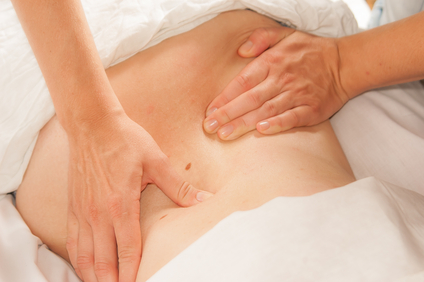 Trigger points (myofascial pain) are small “knots,” or areas of spasm, within a muscle. They may be tender when touched, and/or cause a muscle to shorten. The shortening may then limit the range of motion of the affected area (for example, bending from the low back). Trigger points may even cause “referred pain”: pain felt at a distant location when the trigger point is touched. Pain from these points may come and go spontaneously, or linger hours, days, even months.
Trigger points (myofascial pain) are small “knots,” or areas of spasm, within a muscle. They may be tender when touched, and/or cause a muscle to shorten. The shortening may then limit the range of motion of the affected area (for example, bending from the low back). Trigger points may even cause “referred pain”: pain felt at a distant location when the trigger point is touched. Pain from these points may come and go spontaneously, or linger hours, days, even months.
The causes of trigger points mirror low back pain: accidents, misuse, overuse, misalignments, disk and other spinal problems. The resulting inflammation, along with emotional stressors, cause muscle cells to contract. When the muscle cells contract continuously, they constrict their own blood supply and produce a local “energy crisis” to the muscle cells. When this occurs, the cells do not have enough energy to stop contracting (counter-intuitively, energy is needed to stop contraction), and prolonged spasm and trigger points may ensue.[11]
Trigger Point Therapy loosens these knots, allowing improved blood flow to the chronically spasmodic areas. As a result, the areas begin to heal. As the knots loosen, pain often immediately and markedly improves. The treatment is simple, minimally invasive and quick. When performed in series, improvement is usually noted after each visit.[11]
X
1 Anderssen GBJ. Frymoyer JW (ed.). The epidemiology of spinal disorders, in The Adult Spine: Principles and Practice. New York: Raven Press; 1997:93-141.
2 Cunningham LS, Kelsey JL. Epidemiology of musculoskeletal impairments and associated disability. Am J Public Health. Jun 1984;74(6):574-9. [Medline].
3 National Center for Health Statistics (1977):. Limitations of activity due to chronic conditions, United States. Series 10, No.111. 1974..
4 National Center for Health Statistics (1975):. Physician visits, volume and interval since last visit, United States. 1971. Series 10, No.97.
5 Nachemson Al, Waddell G, Norland AL. Nachemson AL, Jonsson E (eds.). Epidemiology of Neck and Low Back Pain, in. Neck and Back Pain: The scientific evidence of causes, diagnoses, and treatment. Philadelphia: Lippincott Williams & Wilkins; 2000:165-187.
6 Mayer TG, Gatchel RJ. Functional restoration for spinal disorders: The sports medicine approach. Philadelphia: Lea & Febiger; 1988.
7 Biering-Sorenson F. Low back trouble and a general population of 30-, 40-, 50-, and 60–year-old men and women. Dan Med Bull. 1982;29:289-99.
8 Damkot DK, Pope MH, Lord J, Frymoyer JW. The relationship between work history, work environment and low-back pain in men. Spine (Phila Pa 1976). May-Jun 1984;9(4):395-9. [Medline].
9 “Acupuncture Energetics: A Clinical Approach for Physicians”. Joseph M. Helms. Medical Acupuncture Publishers; 1st Edition. (1995)
10 “Foundations of Chinese Medicine: A Comprehensive Text for Acupuncturists and Herbalists”. Giovanni Maciocia. Churchill Livingstone; 2 Edition (July, 2005).
11 “Travell & Simons’ Myofascial Pain and Dysfunction: The Trigger Point Manual”. David G. Simons, Janet G. Travell, Lois S. Simons, Barbara D. Cummings. Lippincott Williams & Wilkins; 2 edition (1998)
12 “Traditional Chinese Medicine Cupping Therapy”. Ilkay Chirali. Churchill & Livinstone; 2 editioin (2007)
13 Argoff CE, Wheeler AH. Backonja MM, ed. Spinal and radicular pain syndromes. Philadelphia, WB Saunders: Neurologic Clinics; 1998:833-45.
14 Wheeler AH. Diagnosis and management of low back pain and sciatica. Am Fam Physician. Oct 1995;52(5):1333-41, 1347-8.
15 Wheeler AH, Murrey DB. Spinal pain: pathogenesis, evolutionary mechanisms, and management, in Pappagallo M (ed). The neurological basis of pain. New York: McGraw-Hill; 2005:421-52.
16 “Essentials of Musk Care”
17 Mooney V. Presidential address. International Society for the Study of the Lumbar Spine. Dallas, 1986. Where is the pain coming from?. Spine (Phila Pa 1976). Oct 1987;12(8):754-9. .
18 Waddell G. 1987 Volvo award in clinical sciences. A new clinical model for the treatment of low-back pain. Spine (Phila Pa 1976). Sep 1987;12(7):632-44.
19 Frymoyer JW. Back pain and sciatica. N Engl J Med. Feb 4 1988;318(5):291-300.
20 Argoff CE, Wheeler AH. Backonja MM, ed. Spinal and radicular pain syndromes. Philadelphia, WB Saunders: Neurologic Clinics; 1998:833-45.
21 Mooney V. Presidential address. International Society for the Study of the Lumbar Spine. Dallas, 1986. Where is the pain coming from?. Spine (Phila Pa 1976). Oct 1987;12(8):754-9.
22 Wheeler AH, Hanley EN Jr. Nonoperative treatment for low back pain. Rest to restoration. Spine (Phila Pa 1976). Feb 1 1995;20(3):375-8. [Medline].
23 Jensen MC, Brant-Zawadzki MN, Obuchowski N, Modic MT, Malkasian D, Ross JS. Magnetic resonance imaging of the lumbar spine in people without back pain. N Engl J Med. Jul 14 1994;331(2):69-73
